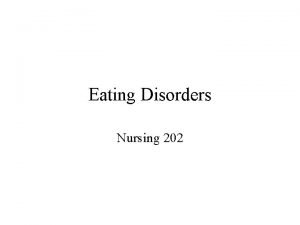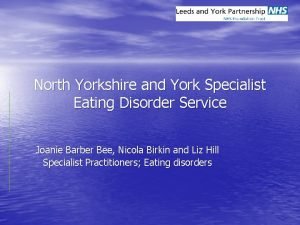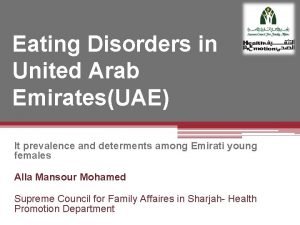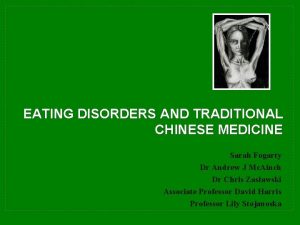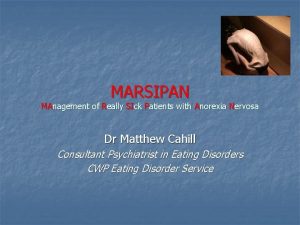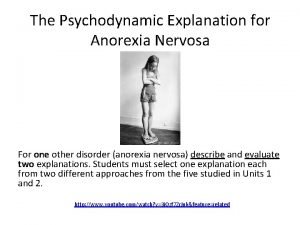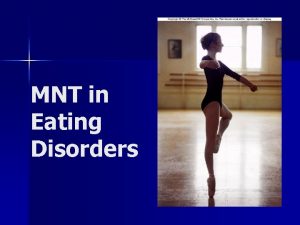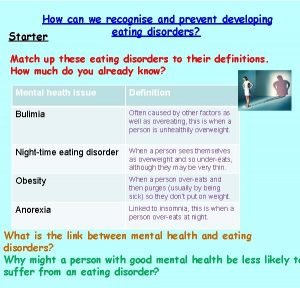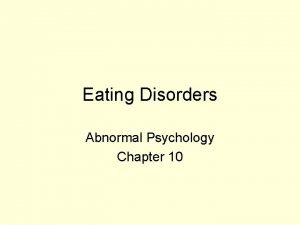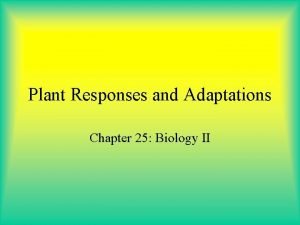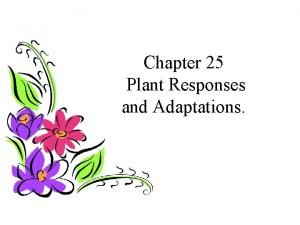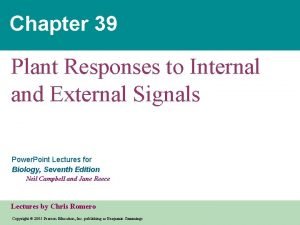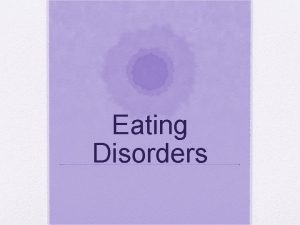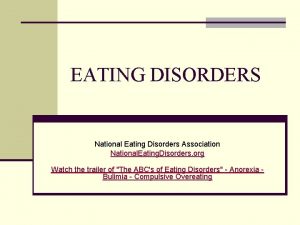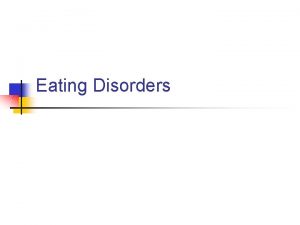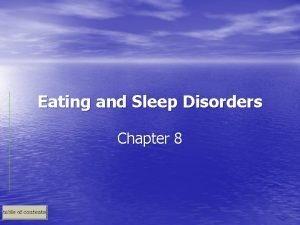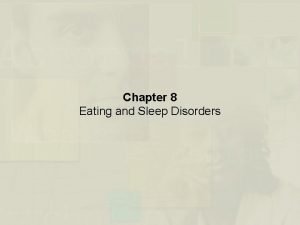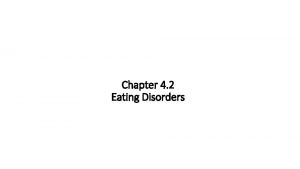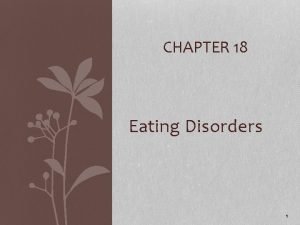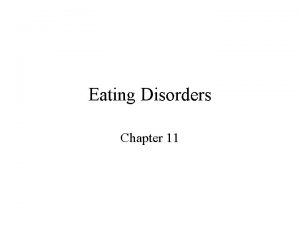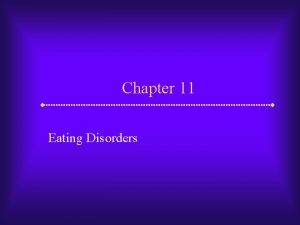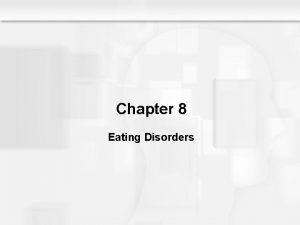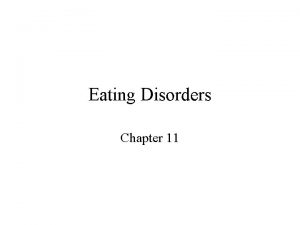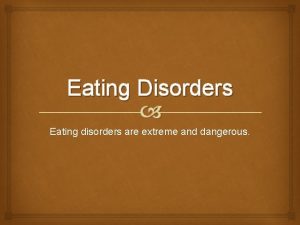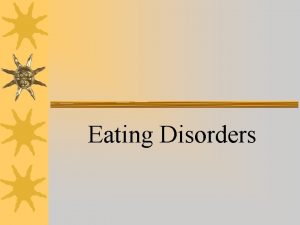Eating Regulation Responses and Eating Disorders Chapter 24
















- Slides: 16

Eating Regulation Responses and Eating Disorders, Chapter 24

Eating Regulation Responses & Eating Disorders • Eating Disorders occur across the life span • Bulimia and Anorexia may be present in the same patient • Both are ↑risk in first-degree female relatives with eating disorders • Patient with eating disorders often have depression, anxiety and substance abuse

Eating Regulation Responses & Eating Disorders • > females • 50 -75% of people with Anorexia or Bulimia have depression • OCD can be found in 25% of patients with Anoroxia Nervosia • Exhibit rigidity, ritualism, and meticulousness – often from early childhood

Eating Regulation Responses & Eating Disorders • Binge eaters often report fluctuation of self-esteem • Sexual abuse reported in 20 -50% of patients with Anorexia or Bulimia • Nurses first must examine their own feelings about weight and size

Eating Regulation Responses & Eating Disorders • Eating disorders include: • • Anorexia nervosa Bulimia nervosa Bing eating disorder Night eating syndrome

Overlapping Relationships Among Eating Disorders (Stuart, 2013, p. 480)

Eating Regulation Responses & Eating Disorders • Anorexia Nervosa • Intense irrational beliefs about body, shape • Intense fear of gaining weight even when under weight • Body weight 15% below expected minimal normal weight for age and height • Female menstrual cycle absent for at least 3 consecutive cycles • Use denial as their coping mechanism

Eating Regulation Responses & Eating Disorders • Anorexia (cont) • Many anorexia nervosa patients recover within 5 years but for some this can be a chronic illness • May consume as little as 200 calories daily • Many are preoccupied by food and are employed in the food industry

Eating Regulation Responses & Eating Disorders • Bulimia Nervosa • More common than anorexia nervosa • Binge eating then purge • Self-induced vomiting • Check for callus on a finger • Misuse of laxatives, diuretics, enemas • Chewing and spitting • Early treatment = good response

Eating Regulation Responses & Eating Disorders • Binge Eating Disorder • Consume large amounts of calories and do not attempt to prevent weight gain • Chronic in nature • 19 -40% obese people who seek help with weight to control binge eat • Assess-what is meant by a binge (calories)

Eating Regulation Responses & Eating Disorders • Night Eating Syndrome • In the new DSM-V • Night eaters experience 2 awakenings a night associated with food • Symptoms associated with night eating syndrome • Morning anorexia • Difficulty staying asleep • Depression in the evening

Eating Regulation Responses & Eating Disorders • Assessment • • Full physical examination Dental examination Psychiatric history Weight history Pattern of menstruation Compulsive exercise patterns Use of laxatives, diuretics, diet pills

Eating Regulation Responses & Eating Disorders • Important assessment with eating disorders is the patient’s motivation to change their behavior • Anorexia is about controlling life and fears • For some the only control they have is their food • Bulimia patients have problems with their weight and resort to purging/laxatives, etc.

Eating Regulation Responses & Eating Disorders • Medical Complications • Anorexia - metabolic and endocrine abnormalities result from malnutrition/starvation • Bulimia – potassium depletion and hypokalemia : related to purging, laxative, or diuretic abuse • Excess weight – HTN, cardiac problems, sleep apnea, mobility, diabetes

Eating Regulation Responses & Eating Disorders • Interventions • • Nutrition stabilization Exercise- physical fitness not calories Cognitive behavioral interventions Body image interventions • Body image distortion- discrepancy between the patient’s actual size and the perceived body size • Body dissatisfaction-degree of unhappiness that a person feels about body size

Eating Regulation Responses & Eating Disorders • Interventions (cont) • Family involvement • Families should be engaged and included • Group therapy • CBT, psychoeducational, psychodynamic, and interpersonal models • Encourage patients to express their feelings • Medications • SSRIs have had considerable to modest to no effect
 Chapter 18 eating and feeding disorders
Chapter 18 eating and feeding disorders An extreme harmful eating behavior
An extreme harmful eating behavior Hypothalamus eating disorders
Hypothalamus eating disorders York eating disorders service
York eating disorders service Eating disorders in uae
Eating disorders in uae Sarah fogarty
Sarah fogarty Eating disorders brainpop answers
Eating disorders brainpop answers Marzipan criteria
Marzipan criteria Freud anorexia
Freud anorexia Mnt for eating disorders
Mnt for eating disorders How to spot eating disorders
How to spot eating disorders Eating disorders abnormal psychology
Eating disorders abnormal psychology Chapter 25 plant responses and adaptations
Chapter 25 plant responses and adaptations Positive geotropism
Positive geotropism Chapter 10 stress responses and stress management
Chapter 10 stress responses and stress management Seed germination
Seed germination Chapter 8 skin disorders and diseases review questions
Chapter 8 skin disorders and diseases review questions


